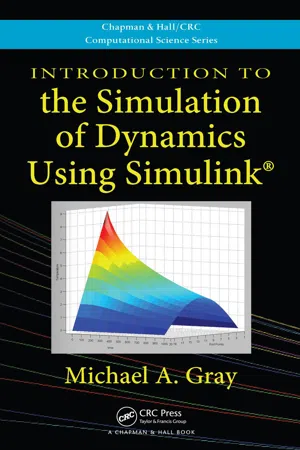
- 332 pages
- English
- PDF
- Available on iOS & Android
Introduction to the Simulation of Dynamics Using Simulink
About This Book
Designed for undergraduate students in the general science, engineering, and mathematics community, Introduction to the Simulation of Dynamics Using Simulink (R) shows how to use the powerful tool of Simulink to investigate and form intuitions about the behavior of dynamical systems. Requiring no prior programming experience, it clearly explains how to transition from physical models described by mathematical equations directly to executable Simulink simulations.
Teaches students how to model and explore the dynamics of systems
Step by step, the author presents the basics of building a simulation in Simulink. He begins with finite difference equations and simple discrete models, such as annual population models, to introduce the concept of state. The text then covers ordinary differential equations, numerical integration algorithms, and time-step simulation. The final chapter offers overviews of some advanced topics, including the simulation of chaotic dynamics and partial differential equations.
A one-semester undergraduate course on simulation
Written in an informal, accessible style, this guide includes many diagrams and graphics as well as exercises embedded within the text. It also draws on numerous examples from the science, engineering, and technology fields. The book deepens students' understanding of simulated systems and prepares them for advanced and specialized studies in simulation.
Frequently asked questions
Information
Table of contents
- Front cover
- Dedication
- Table of Contents
- Preface
- Chapter 1. Introduction and Motivation
- Chapter 2. The Basics of Simulation in Simulink
- Chapter 3. Simulation of First-Order Difference Equation Models
- Chapter 4. Simulation of First-Order Differential Equation Models
- Chapter 5. Fixed-Step Solvers and Numerical Integration Methods
- Chapter 6. Simulation of First-Order Equation Systems
- Chapter 7. Simulation of Second-Order Equation Models: Nonperiodic Dynamics
- Chapter 8. Simulation of Second-Order Equation Models: Periodic Dynamics
- Chapter 9. Higher-Order Models and Variable-Step Solvers
- Chapter 10. Advanced Topics
- Appendix A: Alphabetical List of Simulink Blocks
- Appendix B: The Basics of MATLAB for Simulink Users
- Appendix C: Debugging a Simulink Model
- Back cover